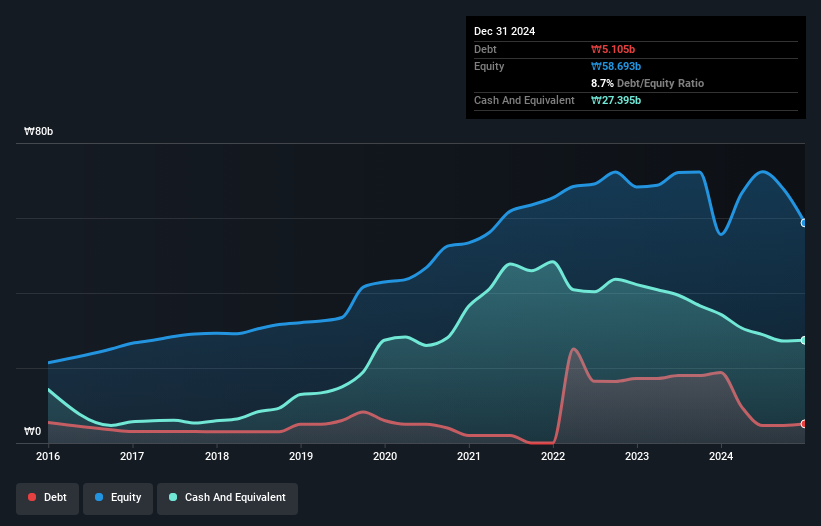Howard Marks put it nicely when he said that, rather than worrying about share price volatility, 'The possibility of permanent loss is the risk I worry about... and every practical investor I know worries about.' So it might be obvious that you need to consider debt, when you think about how risky any given stock is, because too much debt can sink a company. As with many other companies Mr. Blue Corporation (KOSDAQ:207760) makes use of debt. But the real question is whether this debt is making the company risky.
When Is Debt A Problem?
Debt is a tool to help businesses grow, but if a business is incapable of paying off its lenders, then it exists at their mercy. If things get really bad, the lenders can take control of the business. While that is not too common, we often do see indebted companies permanently diluting shareholders because lenders force them to raise capital at a distressed price. By replacing dilution, though, debt can be an extremely good tool for businesses that need capital to invest in growth at high rates of return. The first thing to do when considering how much debt a business uses is to look at its cash and debt together.
What Is Mr. Blue's Debt?
The image below, which you can click on for greater detail, shows that Mr. Blue had debt of ₩5.11b at the end of December 2024, a reduction from ₩18.8b over a year. However, its balance sheet shows it holds ₩27.4b in cash, so it actually has ₩22.3b net cash.

How Healthy Is Mr. Blue's Balance Sheet?
The latest balance sheet data shows that Mr. Blue had liabilities of ₩31.0b due within a year, and liabilities of ₩5.20b falling due after that. Offsetting this, it had ₩27.4b in cash and ₩7.14b in receivables that were due within 12 months. So its liabilities total ₩1.62b more than the combination of its cash and short-term receivables.
Having regard to Mr. Blue's size, it seems that its liquid assets are well balanced with its total liabilities. So it's very unlikely that the ₩109.4b company is short on cash, but still worth keeping an eye on the balance sheet. Despite its noteworthy liabilities, Mr. Blue boasts net cash, so it's fair to say it does not have a heavy debt load! The balance sheet is clearly the area to focus on when you are analysing debt. But you can't view debt in total isolation; since Mr. Blue will need earnings to service that debt. So when considering debt, it's definitely worth looking at the earnings trend. Click here for an interactive snapshot.
See our latest analysis for Mr. Blue
Over 12 months, Mr. Blue made a loss at the EBIT level, and saw its revenue drop to ₩70b, which is a fall of 5.1%. We would much prefer see growth.
So How Risky Is Mr. Blue?
Statistically speaking companies that lose money are riskier than those that make money. And the fact is that over the last twelve months Mr. Blue lost money at the earnings before interest and tax (EBIT) line. Indeed, in that time it burnt through ₩8.8b of cash and made a loss of ₩17b. While this does make the company a bit risky, it's important to remember it has net cash of ₩22.3b. That means it could keep spending at its current rate for more than two years. Summing up, we're a little skeptical of this one, as it seems fairly risky in the absence of free cashflow. There's no doubt that we learn most about debt from the balance sheet. However, not all investment risk resides within the balance sheet - far from it. These risks can be hard to spot. Every company has them, and we've spotted 3 warning signs for Mr. Blue (of which 2 are significant!) you should know about.
If you're interested in investing in businesses that can grow profits without the burden of debt, then check out this free list of growing businesses that have net cash on the balance sheet.
New: Manage All Your Stock Portfolios in One Place
We've created the ultimate portfolio companion for stock investors, and it's free.
• Connect an unlimited number of Portfolios and see your total in one currency
• Be alerted to new Warning Signs or Risks via email or mobile
• Track the Fair Value of your stocks
Have feedback on this article? Concerned about the content? Get in touch with us directly. Alternatively, email editorial-team (at) simplywallst.com.
This article by Simply Wall St is general in nature. We provide commentary based on historical data and analyst forecasts only using an unbiased methodology and our articles are not intended to be financial advice. It does not constitute a recommendation to buy or sell any stock, and does not take account of your objectives, or your financial situation. We aim to bring you long-term focused analysis driven by fundamental data. Note that our analysis may not factor in the latest price-sensitive company announcements or qualitative material. Simply Wall St has no position in any stocks mentioned.
About KOSDAQ:A207760
Mr. Blue
Operates as an entertainment company in South Korea and internationally.
Adequate balance sheet with low risk.
Market Insights
Community Narratives


Recently Updated Narratives


Q3 Outlook modestly optimistic


Alphabet: The Under-appreciated Compounder Hiding in Plain Sight


MINISO's fair value is projected at 26.69 with an anticipated PE ratio shift of 20x
Popular Narratives


The company that turned a verb into a global necessity and basically runs the modern internet, digital ads, smartphones, maps, and AI.


MicroVision will explode future revenue by 380.37% with a vision towards success



